人教版(2019)必修第一册Unit 4 Natural Disasters Reading and Thinking 课件 (共26张PPT)
文档属性
| 名称 | 人教版(2019)必修第一册Unit 4 Natural Disasters Reading and Thinking 课件 (共26张PPT) | 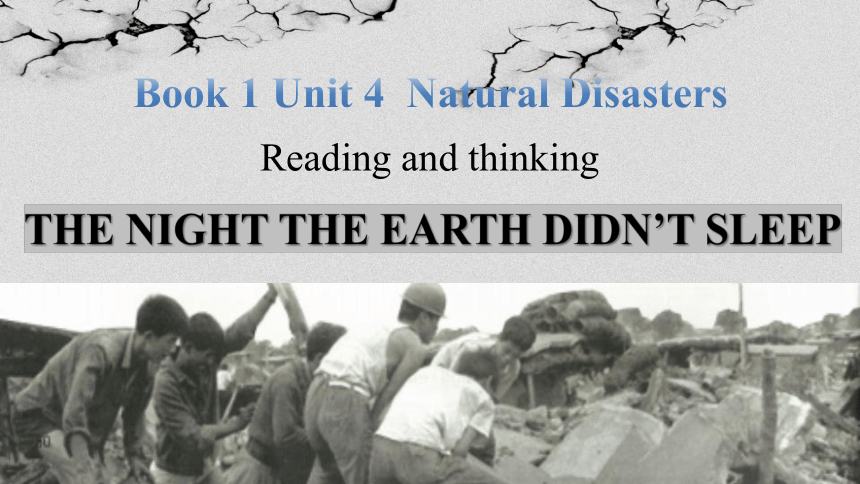 | |
| 格式 | pptx | ||
| 文件大小 | 23.7MB | ||
| 资源类型 | 教案 | ||
| 版本资源 | 人教版(2019) | ||
| 科目 | 英语 | ||
| 更新时间 | 2023-11-14 21:49:26 | ||
图片预览

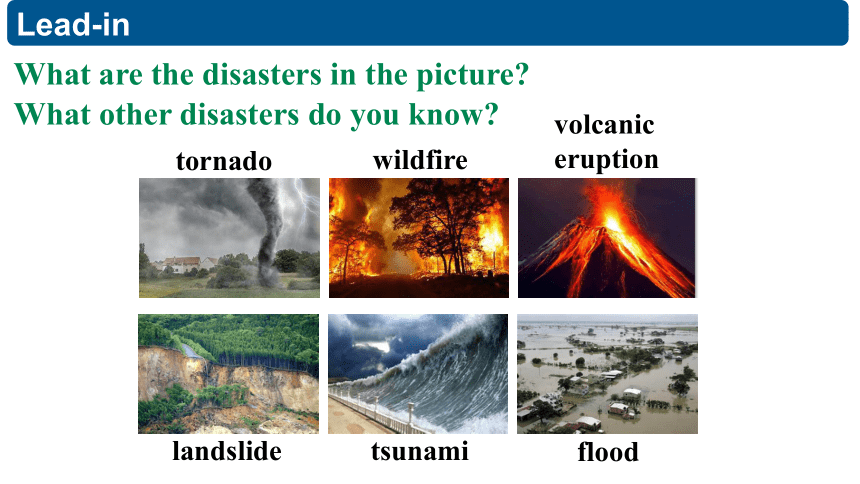
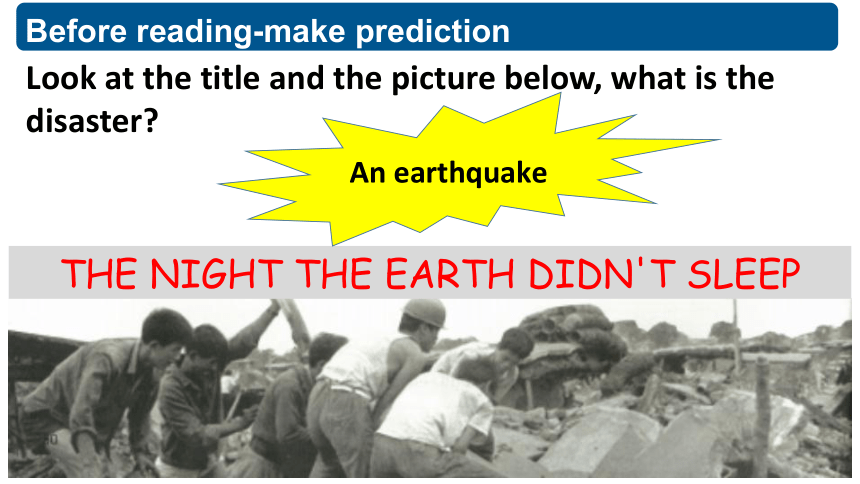
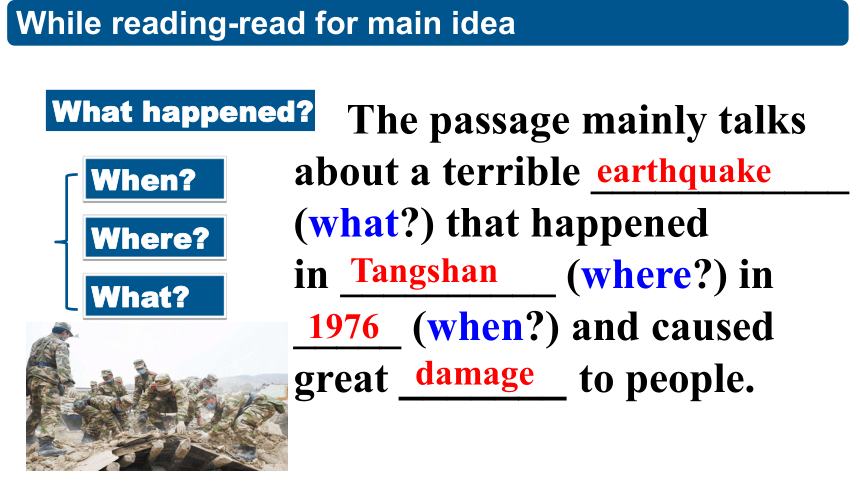
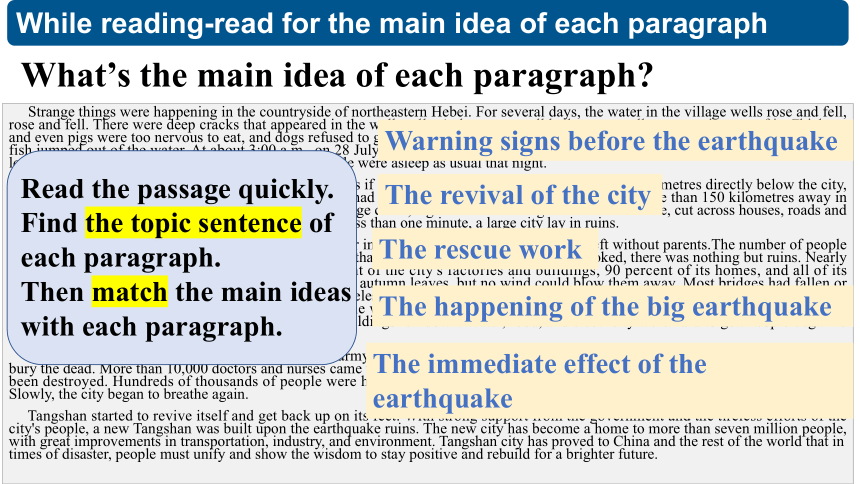
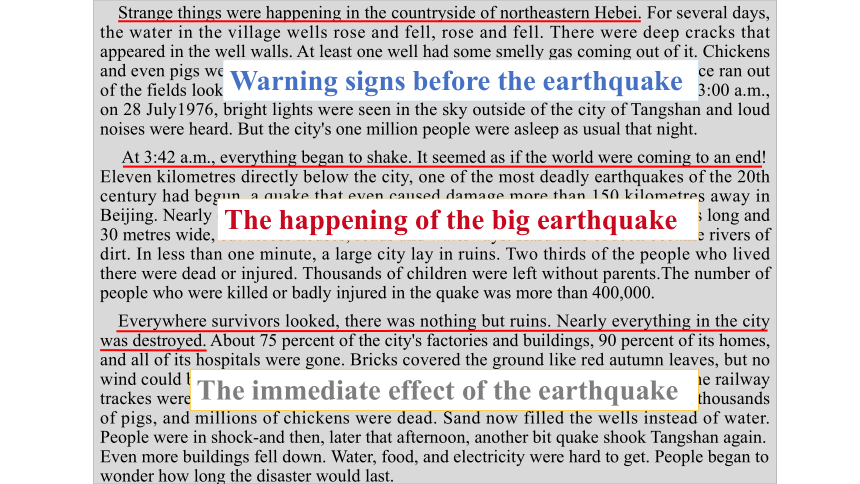
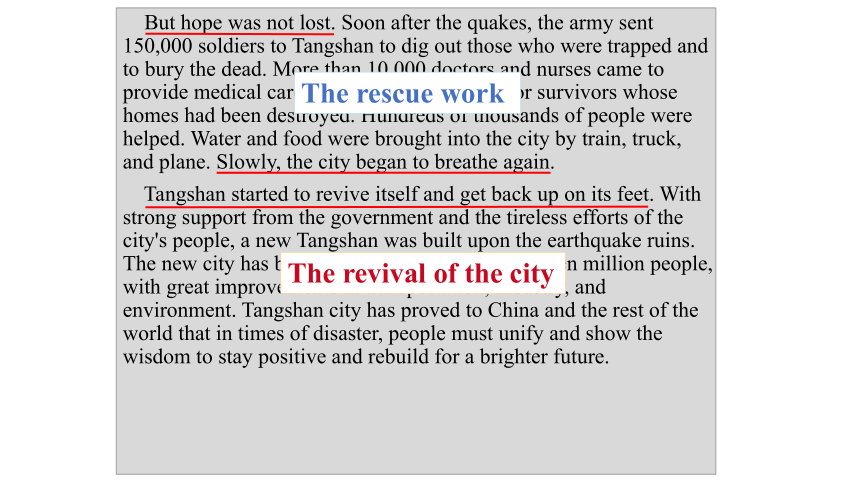
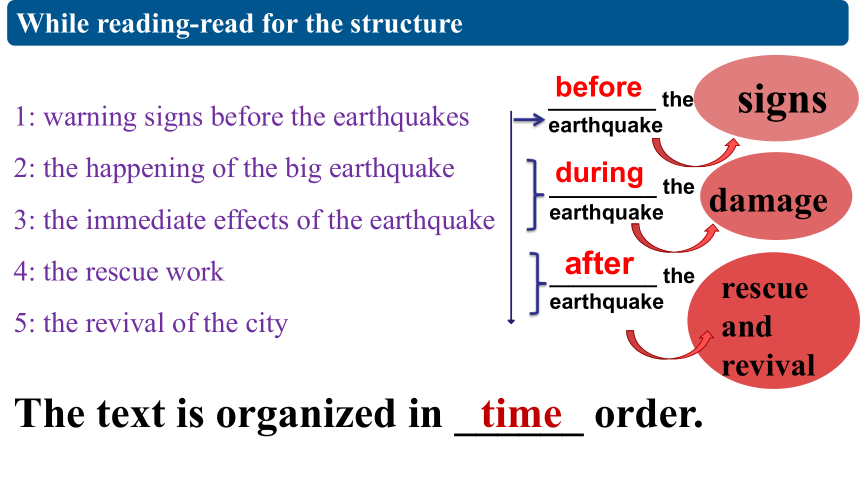
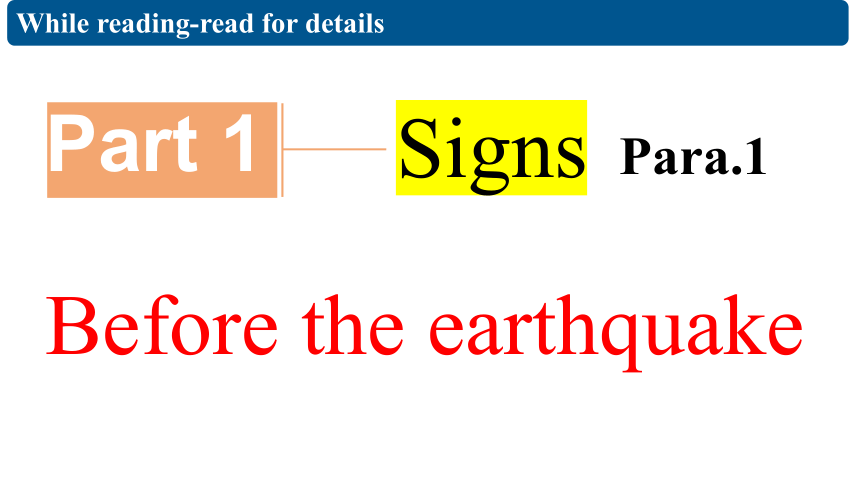
文档简介
(共26张PPT)
Reading and thinking
THE NIGHT THE EARTH DIDN’T SLEEP
Book 1 Unit 4 Natural Disasters
What are the disasters in the picture
tornado
wildfire
landslide
tsunami
flood
volcanic
eruption
Lead-in
What other disasters do you know
Look at the title and the picture below, what is the disaster
Before reading-make prediction
THE NIGHT THE EARTH DIDN'T SLEEP
An earthquake
When
Where
What
The passage mainly talks about a terrible ____________ (what ) that happened
in __________ (where ) in _____ (when ) and caused great _______ to people.
earthquake
Tangshan
1976
damage
While reading-read for main idea
What happened
What’s the main idea of each paragraph
While reading-read for the main idea of each paragraph
Strange things were happening in the countryside of northeastern Hebei. For several days, the water in the village wells rose and fell, rose and fell. There were deep cracks that appeared in the well walls. At least one well had some smelly gas coming out of it. Chickens and even pigs were too nervous to eat, and dogs refused to go inside buildings. Mice ran out of the fields looking for places to hide, and fish jumped out of the water. At about 3:00 a.m., on 28 July1976, bright lights were seen in the sky outside of the city of Tangshan and loud noises were heard. But the city's one million people were asleep as usual that night.
At 3:42 a.m., everything began to shake. It seemed as if the world were coming to an end! Eleven kilometres directly below the city, one of the most deadly earthquakes of the 20th century had begun, a quake that even caused damage more than 150 kilometres away in Beijing. Nearly one third of the whole nation felt it! A huge crack, eight kilometres long and 30 metres wide, cut across houses, roads and waterways. Hard hills of rock became rivers of dirt. In less than one minute, a large city lay in ruins.
Two thirds of the people who lived there were dead or injured. Thousands of children were left without parents.The number of people who were killed or badly injured in the quake was more than 400,000. Everywhere survivors looked, there was nothing but ruins. Nearly everything in the city was destroyed. About 75 percent of the city's factories and buildings, 90 percent of its homes, and all of its hospitals were gone. Bricks covered the ground like red autumn leaves, but no wind could blow them away. Most bridges had fallen or were not safe to cross. The railway trackes were now useless pieces of metal. Tens of thousands of cows,hundreds of thousands of pigs, and millions of chickens were dead. Sand now filled the wells instead of water. People were in shock-and then, later that afternoon, another bit quake shook Tangshan again. Even more buildings fell down. Water, food, and electricity were hard to get. People began to wonder how long the disaster would last.
But hope was not lost. Soon after the quakes, the army sent 150,000 soldiers to Tangshan to dig out those who were trapped and to bury the dead. More than 10,000 doctors and nurses came to provide medical care. Workers built shelters for survivors whose homes had been destroyed. Hundreds of thousands of people were helped. Water and food were brought into the city by train, truck, and plane. Slowly, the city began to breathe again.
Tangshan started to revive itself and get back up on its feet. With strong support from the government and the tireless efforts of the city's people, a new Tangshan was built upon the earthquake ruins. The new city has become a home to more than seven million people, with great improvements in transportation, industry, and environment. Tangshan city has proved to China and the rest of the world that in times of disaster, people must unify and show the wisdom to stay positive and rebuild for a brighter future.
Read the passage quickly. Find the topic sentence of each paragraph.
Then match the main ideas with each paragraph.
Warning signs before the earthquake
The happening of the big earthquake
The immediate effect of the earthquake
The rescue work
The revival of the city
Strange things were happening in the countryside of northeastern Hebei. For several days, the water in the village wells rose and fell, rose and fell. There were deep cracks that appeared in the well walls. At least one well had some smelly gas coming out of it. Chickens and even pigs were too nervous to eat, and dogs refused to go inside buildings. Mice ran out of the fields looking for places to hide, and fish jumped out of the water. At about 3:00 a.m., on 28 July1976, bright lights were seen in the sky outside of the city of Tangshan and loud noises were heard. But the city's one million people were asleep as usual that night.
At 3:42 a.m., everything began to shake. It seemed as if the world were coming to an end! Eleven kilometres directly below the city, one of the most deadly earthquakes of the 20th century had begun, a quake that even caused damage more than 150 kilometres away in Beijing. Nearly one third of the whole nation felt it! A huge crack, eight kilometres long and 30 metres wide, cut across houses, roads and waterways. Hard hills of rock became rivers of dirt. In less than one minute, a large city lay in ruins. Two thirds of the people who lived there were dead or injured. Thousands of children were left without parents.The number of people who were killed or badly injured in the quake was more than 400,000.
Everywhere survivors looked, there was nothing but ruins. Nearly everything in the city was destroyed. About 75 percent of the city's factories and buildings, 90 percent of its homes, and all of its hospitals were gone. Bricks covered the ground like red autumn leaves, but no wind could blow them away. Most bridges had fallen or were not safe to cross. The railway trackes were now useless pieces of metal. Tens of thousands of cows,hundreds of thousands of pigs, and millions of chickens were dead. Sand now filled the wells instead of water. People were in shock-and then, later that afternoon, another bit quake shook Tangshan again. Even more buildings fell down. Water, food, and electricity were hard to get. People began to wonder how long the disaster would last.
Warning signs before the earthquake
The happening of the big earthquake
The immediate effect of the earthquake
But hope was not lost. Soon after the quakes, the army sent 150,000 soldiers to Tangshan to dig out those who were trapped and to bury the dead. More than 10,000 doctors and nurses came to provide medical care. Workers built shelters for survivors whose homes had been destroyed. Hundreds of thousands of people were helped. Water and food were brought into the city by train, truck, and plane. Slowly, the city began to breathe again.
Tangshan started to revive itself and get back up on its feet. With strong support from the government and the tireless efforts of the city's people, a new Tangshan was built upon the earthquake ruins. The new city has become a home to more than seven million people, with great improvements in transportation, industry, and environment. Tangshan city has proved to China and the rest of the world that in times of disaster, people must unify and show the wisdom to stay positive and rebuild for a brighter future.
The rescue work
The revival of the city
1: warning signs before the earthquakes
2: the happening of the big earthquake
3: the immediate effects of the earthquake
4: the rescue work
5: the revival of the city
_________ the earthquake
_________ the earthquake
_________ the earthquake
While-reading
While reading-read for the structure
The text is organized in ______ order.
time
signs
damage
rescue and revival
before
during
after
Part 1
Before the earthquake
Signs
Para.1
While reading-read for details
Fill in the blanks by time order.
Time Details
______ the earth-quake (para.1) For several days 1.Water in the village wells
_______________ .
2.Well walls developed ____________
3.___________ come out of the cracks.
4. Mice ___________ the fields.
5. Fish _______________ the water.
At about 3:00 a.m. on July 28,1976 1. ______________appeared in the sky.
2. _____________ were heard.
rose and fell
deep cracks
Smelly gas
ran out of
jumped out of
Bright lights
Loud noises
What was people’s attitude towards these strange things
Before
Warning signs of the quake.
People ignored the warning signs.
Part 2
During the earthquake
damage
Para.2-3
Listen to paragraphs 2 and 3 and circle the data/numbers
While reading-read for details
The damage caused by the earthquake
At 3:42 a.m., __________________________.
_____________, eight kilometres long and 30 metres wide.
Nearly one third of the nation ___________________.
75% of the ___________________________, 90% of _________, were gone.
Ten thousands of _____, hundreds of thousands of ______, and millions of ________ were dead.
everything began to shake
felt the earthquake
city’s factories and buildings
A huge crack
Fill in the blanks of the meaning behind the numbers
its homes
cows
pigs
chickens
The suffering of the people
Two thirds of the people ____________________ during the earthquake.
Thousands of children ________________________.
The number of people who were___________________ reached more than 400000.
were died or injuried
killed or badly injuried
were left without parents
to show the earthquake was very _______ and it _______________________ to people and the city.
to make the article more _________ and ___________.
serious
caused a lot of damage
convincing
objective
Why numbers are widely used in this text
Part 3
After the earthquake
rescue and revival
Para.4-5
While reading-read for details
Who came to the rescue What did they do
come back to life or recover
But hope was not lost. Soon after the quakes,
the army sent 150,000 soldiers to Tangshan to dig out those who were trapped and to bury the dead. More than 10,000 doctors and nurses came to provide medical care. Workers built shelters for survivors whose homes had been destroyed. Hundreds of thousands of people were helped. Water and food were brought into the city by train, truck, and plane. Slowly, the city began to breathe again.
Tangshan has now taken on a new look.
A heroic city!
Think about the change of people’s feelings.
the change of people’s feelings
the timeline of the earthquake
at 3:00 am
at 3:42 am
after the quakes
unaware
shocked
hopeless
hopeful
The city's one million people were asleep as usual that night.
Everything began to shake. People were in shock.
People began to wonder how long the disaster would last.
But hope was not lost. Slowly, the city began to breathe again.
later that afternoon
What can we learn from Tangshan’s revival
In times of disaster, people must unify and show the wisdom to stay positive and rebuild for a brighter future.
If everyone gives a hand, the world would be full of love.
Disasters have no mercy, but humans do.
Union is strength.
Post reading-discussion
Discuss with you partner
Why is the damage caused by the Tangshan earthquake so severe
Post reading-discussion
Suppose there would be an
earthquake when you were in
the classroom, how would you
keep yourselves safe
Don’t be nervous and keep calm.
Don’t try to run out of the classroom.
Protect your head by putting your bag on your head.
Sit down under your desk.
Leave the classroom after the earthquake.
Don't rush out without order.
Never try to use the lift.
Avoid the buildings and bridges.
Homework
1. Finish textbook P.51 and workbook P.89.
2. Underline the important expressions in the text, analyze the language points.
Reading and thinking
THE NIGHT THE EARTH DIDN’T SLEEP
Book 1 Unit 4 Natural Disasters
What are the disasters in the picture
tornado
wildfire
landslide
tsunami
flood
volcanic
eruption
Lead-in
What other disasters do you know
Look at the title and the picture below, what is the disaster
Before reading-make prediction
THE NIGHT THE EARTH DIDN'T SLEEP
An earthquake
When
Where
What
The passage mainly talks about a terrible ____________ (what ) that happened
in __________ (where ) in _____ (when ) and caused great _______ to people.
earthquake
Tangshan
1976
damage
While reading-read for main idea
What happened
What’s the main idea of each paragraph
While reading-read for the main idea of each paragraph
Strange things were happening in the countryside of northeastern Hebei. For several days, the water in the village wells rose and fell, rose and fell. There were deep cracks that appeared in the well walls. At least one well had some smelly gas coming out of it. Chickens and even pigs were too nervous to eat, and dogs refused to go inside buildings. Mice ran out of the fields looking for places to hide, and fish jumped out of the water. At about 3:00 a.m., on 28 July1976, bright lights were seen in the sky outside of the city of Tangshan and loud noises were heard. But the city's one million people were asleep as usual that night.
At 3:42 a.m., everything began to shake. It seemed as if the world were coming to an end! Eleven kilometres directly below the city, one of the most deadly earthquakes of the 20th century had begun, a quake that even caused damage more than 150 kilometres away in Beijing. Nearly one third of the whole nation felt it! A huge crack, eight kilometres long and 30 metres wide, cut across houses, roads and waterways. Hard hills of rock became rivers of dirt. In less than one minute, a large city lay in ruins.
Two thirds of the people who lived there were dead or injured. Thousands of children were left without parents.The number of people who were killed or badly injured in the quake was more than 400,000. Everywhere survivors looked, there was nothing but ruins. Nearly everything in the city was destroyed. About 75 percent of the city's factories and buildings, 90 percent of its homes, and all of its hospitals were gone. Bricks covered the ground like red autumn leaves, but no wind could blow them away. Most bridges had fallen or were not safe to cross. The railway trackes were now useless pieces of metal. Tens of thousands of cows,hundreds of thousands of pigs, and millions of chickens were dead. Sand now filled the wells instead of water. People were in shock-and then, later that afternoon, another bit quake shook Tangshan again. Even more buildings fell down. Water, food, and electricity were hard to get. People began to wonder how long the disaster would last.
But hope was not lost. Soon after the quakes, the army sent 150,000 soldiers to Tangshan to dig out those who were trapped and to bury the dead. More than 10,000 doctors and nurses came to provide medical care. Workers built shelters for survivors whose homes had been destroyed. Hundreds of thousands of people were helped. Water and food were brought into the city by train, truck, and plane. Slowly, the city began to breathe again.
Tangshan started to revive itself and get back up on its feet. With strong support from the government and the tireless efforts of the city's people, a new Tangshan was built upon the earthquake ruins. The new city has become a home to more than seven million people, with great improvements in transportation, industry, and environment. Tangshan city has proved to China and the rest of the world that in times of disaster, people must unify and show the wisdom to stay positive and rebuild for a brighter future.
Read the passage quickly. Find the topic sentence of each paragraph.
Then match the main ideas with each paragraph.
Warning signs before the earthquake
The happening of the big earthquake
The immediate effect of the earthquake
The rescue work
The revival of the city
Strange things were happening in the countryside of northeastern Hebei. For several days, the water in the village wells rose and fell, rose and fell. There were deep cracks that appeared in the well walls. At least one well had some smelly gas coming out of it. Chickens and even pigs were too nervous to eat, and dogs refused to go inside buildings. Mice ran out of the fields looking for places to hide, and fish jumped out of the water. At about 3:00 a.m., on 28 July1976, bright lights were seen in the sky outside of the city of Tangshan and loud noises were heard. But the city's one million people were asleep as usual that night.
At 3:42 a.m., everything began to shake. It seemed as if the world were coming to an end! Eleven kilometres directly below the city, one of the most deadly earthquakes of the 20th century had begun, a quake that even caused damage more than 150 kilometres away in Beijing. Nearly one third of the whole nation felt it! A huge crack, eight kilometres long and 30 metres wide, cut across houses, roads and waterways. Hard hills of rock became rivers of dirt. In less than one minute, a large city lay in ruins. Two thirds of the people who lived there were dead or injured. Thousands of children were left without parents.The number of people who were killed or badly injured in the quake was more than 400,000.
Everywhere survivors looked, there was nothing but ruins. Nearly everything in the city was destroyed. About 75 percent of the city's factories and buildings, 90 percent of its homes, and all of its hospitals were gone. Bricks covered the ground like red autumn leaves, but no wind could blow them away. Most bridges had fallen or were not safe to cross. The railway trackes were now useless pieces of metal. Tens of thousands of cows,hundreds of thousands of pigs, and millions of chickens were dead. Sand now filled the wells instead of water. People were in shock-and then, later that afternoon, another bit quake shook Tangshan again. Even more buildings fell down. Water, food, and electricity were hard to get. People began to wonder how long the disaster would last.
Warning signs before the earthquake
The happening of the big earthquake
The immediate effect of the earthquake
But hope was not lost. Soon after the quakes, the army sent 150,000 soldiers to Tangshan to dig out those who were trapped and to bury the dead. More than 10,000 doctors and nurses came to provide medical care. Workers built shelters for survivors whose homes had been destroyed. Hundreds of thousands of people were helped. Water and food were brought into the city by train, truck, and plane. Slowly, the city began to breathe again.
Tangshan started to revive itself and get back up on its feet. With strong support from the government and the tireless efforts of the city's people, a new Tangshan was built upon the earthquake ruins. The new city has become a home to more than seven million people, with great improvements in transportation, industry, and environment. Tangshan city has proved to China and the rest of the world that in times of disaster, people must unify and show the wisdom to stay positive and rebuild for a brighter future.
The rescue work
The revival of the city
1: warning signs before the earthquakes
2: the happening of the big earthquake
3: the immediate effects of the earthquake
4: the rescue work
5: the revival of the city
_________ the earthquake
_________ the earthquake
_________ the earthquake
While-reading
While reading-read for the structure
The text is organized in ______ order.
time
signs
damage
rescue and revival
before
during
after
Part 1
Before the earthquake
Signs
Para.1
While reading-read for details
Fill in the blanks by time order.
Time Details
______ the earth-quake (para.1) For several days 1.Water in the village wells
_______________ .
2.Well walls developed ____________
3.___________ come out of the cracks.
4. Mice ___________ the fields.
5. Fish _______________ the water.
At about 3:00 a.m. on July 28,1976 1. ______________appeared in the sky.
2. _____________ were heard.
rose and fell
deep cracks
Smelly gas
ran out of
jumped out of
Bright lights
Loud noises
What was people’s attitude towards these strange things
Before
Warning signs of the quake.
People ignored the warning signs.
Part 2
During the earthquake
damage
Para.2-3
Listen to paragraphs 2 and 3 and circle the data/numbers
While reading-read for details
The damage caused by the earthquake
At 3:42 a.m., __________________________.
_____________, eight kilometres long and 30 metres wide.
Nearly one third of the nation ___________________.
75% of the ___________________________, 90% of _________, were gone.
Ten thousands of _____, hundreds of thousands of ______, and millions of ________ were dead.
everything began to shake
felt the earthquake
city’s factories and buildings
A huge crack
Fill in the blanks of the meaning behind the numbers
its homes
cows
pigs
chickens
The suffering of the people
Two thirds of the people ____________________ during the earthquake.
Thousands of children ________________________.
The number of people who were___________________ reached more than 400000.
were died or injuried
killed or badly injuried
were left without parents
to show the earthquake was very _______ and it _______________________ to people and the city.
to make the article more _________ and ___________.
serious
caused a lot of damage
convincing
objective
Why numbers are widely used in this text
Part 3
After the earthquake
rescue and revival
Para.4-5
While reading-read for details
Who came to the rescue What did they do
come back to life or recover
But hope was not lost. Soon after the quakes,
the army sent 150,000 soldiers to Tangshan to dig out those who were trapped and to bury the dead. More than 10,000 doctors and nurses came to provide medical care. Workers built shelters for survivors whose homes had been destroyed. Hundreds of thousands of people were helped. Water and food were brought into the city by train, truck, and plane. Slowly, the city began to breathe again.
Tangshan has now taken on a new look.
A heroic city!
Think about the change of people’s feelings.
the change of people’s feelings
the timeline of the earthquake
at 3:00 am
at 3:42 am
after the quakes
unaware
shocked
hopeless
hopeful
The city's one million people were asleep as usual that night.
Everything began to shake. People were in shock.
People began to wonder how long the disaster would last.
But hope was not lost. Slowly, the city began to breathe again.
later that afternoon
What can we learn from Tangshan’s revival
In times of disaster, people must unify and show the wisdom to stay positive and rebuild for a brighter future.
If everyone gives a hand, the world would be full of love.
Disasters have no mercy, but humans do.
Union is strength.
Post reading-discussion
Discuss with you partner
Why is the damage caused by the Tangshan earthquake so severe
Post reading-discussion
Suppose there would be an
earthquake when you were in
the classroom, how would you
keep yourselves safe
Don’t be nervous and keep calm.
Don’t try to run out of the classroom.
Protect your head by putting your bag on your head.
Sit down under your desk.
Leave the classroom after the earthquake.
Don't rush out without order.
Never try to use the lift.
Avoid the buildings and bridges.
Homework
1. Finish textbook P.51 and workbook P.89.
2. Underline the important expressions in the text, analyze the language points.
